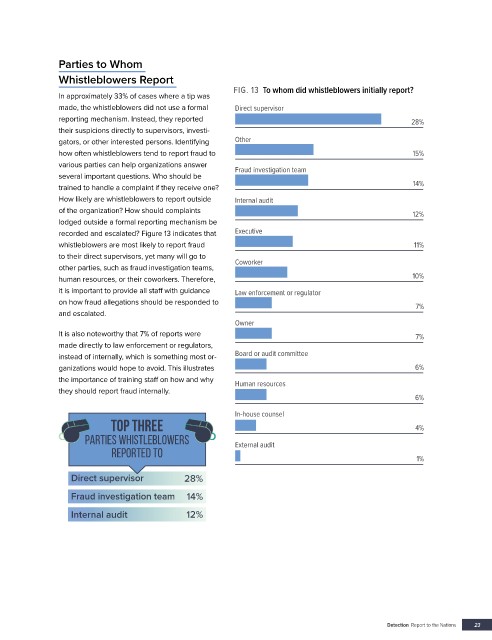Page 679 - ACFE Fraud Reports 2009_2020
P. 679
Parties to Whom
Whistleblowers Report
FIG. 13 To whom did whistleblowers initially report?
In approximately 33% of cases where a tip was
made, the whistleblowers did not use a formal Direct supervisor
reporting mechanism. Instead, they reported 28%
their suspicions directly to supervisors, investi-
gators, or other interested persons. Identifying Other
how often whistleblowers tend to report fraud to 15%
various parties can help organizations answer Fraud investigation team
several important questions. Who should be
trained to handle a complaint if they receive one? 14%
How likely are whistleblowers to report outside Internal audit
of the organization? How should complaints 12%
lodged outside a formal reporting mechanism be
recorded and escalated? Figure 13 indicates that Executive
whistleblowers are most likely to report fraud 11%
to their direct supervisors, yet many will go to Coworker
other parties, such as fraud investigation teams,
human resources, or their coworkers. Therefore, 10%
it is important to provide all staff with guidance Law enforcement or regulator
on how fraud allegations should be responded to 7%
and escalated.
Owner
It is also noteworthy that 7% of reports were 7%
made directly to law enforcement or regulators,
instead of internally, which is something most or- Board or audit committee
ganizations would hope to avoid. This illustrates 6%
the importance of training staff on how and why Human resources
they should report fraud internally.
6%
In-house counsel
TOP THREE 4%
Parties whistleblowers External audit
reported to 1%
Direct supervisor 28%
Fraud investigation team 14%
Internal audit 12%
Detection Report to the Nations 23

